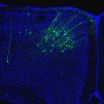(Press-News.org) Aromatic compounds are found widely in natural resources such as petroleum and biomass, and breaking the carbon?carbon bonds in these compounds plays an important role in the production of fuels and valuable chemicals from natural resources. However, aromatic carbon-carbon bonds are very stable and difficult to break. In the chemical industry, the cleavage of these bonds requires the use of solid catalysts at high temperatures, usually giving rise to a mixture of products, and the mechanisms are still poorly understood.
Now, in research published in Nature, Zhaomin Hou and colleagues from the RIKEN Center for Sustainable Resource Science in Japan have demonstrated a way to use a metallic complex, trinuclear titanium hydride, to accomplish the task of activating benzene by breaking the aromatic carbon-carbon bonds at relatively mild temperatures and in a highly selective way.
This paper reports the first example of carbon-carbon bond cleavage and rearrangement of benzene by a well-defined molecular system. It not only offers unprecedented mechanistic details on the hydrocracking of the benzene ring, an important industrial process of petroleum refining, but also demonstrates for the first time that molecular multimetallic hydrides can serve as a unique platform for breaking inactive aromatic molecules.
The authors previously demonstrated, from a serendipitous finding, that multimetallic hydride clusters can serve as a platform for the activation of dinitrogen through cooperation of the multiple metal hydride sites, which could contribute to easier production of ammonia fertilizers. At that time, they envisioned that these synergistic effects might also be used for the activation of other inactive chemical bonds such as C-H and C-C bonds. This led to the current discovery.
Zhaomin Hou, who led the research, says, "This work deepens our understanding of carbon-carbon bond cleavage. We were able to achieve the cleavage of benzene at room temperature with a multimetallic polyhydride compound, thanks to the synergistic effects of the multiple metal hydride active sites, offering information on the reaction mechanism at the molecular level. This could help us to design new catalysts for more efficient and selective production of useful materials from natural resources."
INFORMATION:
Breaking benzene
2014-08-27
ELSE PRESS RELEASES FROM THIS DATE:
Walking fish reveal how our ancestors evolved onto land
2014-08-27
VIDEO:
Polypterus senegalus walks across a sandy substrate. Fish use their fins and body in combination to move across a terrestrial substrate. Fins are planted one after the other to lift...
Click here for more information.
About 400 million years ago a group of fish began exploring land and evolved into tetrapods – today's amphibians, reptiles, birds, and mammals. But just how these ancient fish used their fishy bodies and fins in a terrestrial environment and what evolutionary ...
NIH issues finalized policy on genomic data sharing
2014-08-27
The National Institutes of Health has issued a final NIH Genomic Data Sharing (GDS) policy to promote data sharing as a way to speed the translation of data into knowledge, products and procedures that improve health while protecting the privacy of research participants. The final policy was posted in the Federal Register Aug. 26, 2014 and published in the NIH Guide for Grants and Contracts Aug. 27, 2014.
Starting with funding applications submitted for a Jan. 25, 2015, receipt date, the policy will apply to all NIH-funded, large-scale human and non-human projects that ...
Scientists looking across human, fly and worm genomes find shared biology
2014-08-27
Researchers analyzing human, fly, and worm genomes have found that these species have a number of key genomic processes in common, reflecting their shared ancestry. The findings, appearing Aug. 28, 2014, in the journal Nature, offer insights into embryonic development, gene regulation and other biological processes vital to understanding human biology and disease.
The studies highlight the data generated by the modENCODE Project and the ENCODE Project, both supported by the National Human Genome Research Institute (NHGRI), part of the National Institutes of Health. ...
Worms, flies and humans... Our common genomic legacy, key to understanding cell biology
2014-08-27
This news release is available in Spanish. Genomes accumulate changes and mutations throughout evolution. These changes have resulted in a huge diversity of species and in different traits between us. But animal cells, whether they are from a fly or a human, work similarly: they have common molecular mechanisms.
Based on this premise, an international consortium with participation of scientists from the Centre for Genomic Regulation in Barcelona have compared the transcriptome (the RNA complement of a species' cell) of different animal species. They used data from ...
Snowfall in a warmer world
2014-08-27
If ever there were a silver lining to global warming, it might be the prospect of milder winters. After all, it stands to reason that a warmer climate would generate less snow.
But a new MIT study suggests that you shouldn't put your shovels away just yet. While most areas in the Northern Hemisphere will likely experience less snowfall throughout a season, the study concludes that extreme snow events will still occur, even in a future with significant warming. That means that, for example, places like Boston may see less snowy winters overall, punctuated in some years ...
Researchers change the emotional association of memories
2014-08-27
By manipulating neural circuits in the brain of mice, scientists have altered the emotional associations of specific memories. The research, led by Howard Hughes Medical Institute investigator Susumu Tonegawa at the Massachusetts Institute of Technology (MIT), reveals that the connections between the part of the brain that stores contextual information about an experience and the part of the brain that stores the emotional memory of that experience are malleable.
Altering those connections can transform a negative memory into a positive one, Tonegawa and his MIT colleagues ...
Witnessing the early growth of a giant
2014-08-27
Elliptical galaxies are large, gas-poor gatherings of older stars and are one of the main types of galaxy along with their spiral and lenticular relatives. Galaxy formation theories suggest that giant elliptical galaxies form from the inside out, with a large core marking the very first stages of formation.
However, evidence of this early construction phase has eluded astronomers — until now.
Astronomers have now spotted a compact galactic core known as GOODS-N-774, and nicknamed Sparky [1]. It is seen as it appeared eleven billion years ago, just three billion years ...
Stop and listen: Study shows how movement affects hearing
2014-08-27
DURHAM, N.C. -- When we want to listen carefully to someone, the first thing we do is stop talking. The second thing we do is stop moving altogether. This strategy helps us hear better by preventing unwanted sounds generated by our own movements.
This interplay between movement and hearing also has a counterpart deep in the brain. Indeed, indirect evidence has long suggested that the brain's motor cortex, which controls movement, somehow influences the auditory cortex, which gives rise to our conscious perception of sound.
A new Duke study, appearing online August 27 ...
NASA sees massive Marie close enough to affect southern California coast
2014-08-27
Two NASA satellites captured visible and infrared pictures that show the massive size of Hurricane Marie. Marie is so large that it is bringing rough surf to the southern coast of California while almost nine hundred miles west of Baja California.
On August 26 at 19:05 UTC (3:05 p.m. EDT) NASA's Terra satellite captured a visible image of Hurricane Marie drawing in the small remnants of Karina. Marie is over 400 miles in diameter, about the distance from Washington, D.C. to Boston, Massachusetts. Hurricane force winds extend outward up to 60 miles (95 km) from the center ...
Scripps Research Institute scientists link alcohol-dependence gene to neurotransmitter
2014-08-27
LA JOLLA, CA – August 27, 2014 – Scientists at The Scripps Research Institute (TSRI) have solved the mystery of why a specific signaling pathway can be associated with alcohol dependence.
This signaling pathway is regulated by a gene, called neurofibromatosis type 1 (Nf1), which TSRI scientists found is linked with excessive drinking in mice. The new research shows Nf1 regulates gamma-aminobutyric acid (GABA), a neurotransmitter that lowers anxiety and increases feelings of relaxation.
"This novel and seminal study provides insights into the cellular mechanisms of ...




